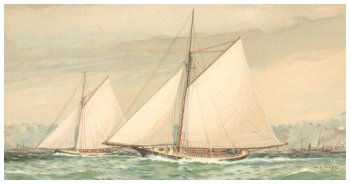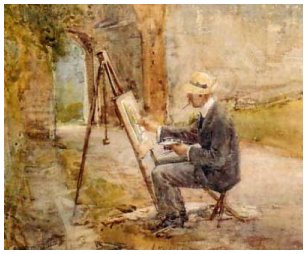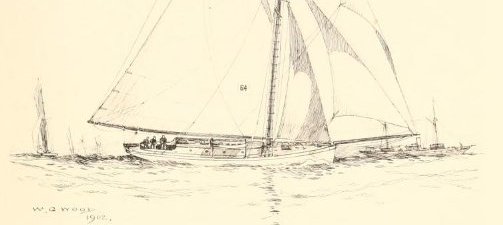Yves GARY Hits: 6956
Category: MISCHIEF
 An English member of the New York Yacht Club, Joseph R. Busk, owned Mischief. He lived near Newport, but he was not a naturalised American in 1881. However, it was his yacht that would be selected after elimination trials as the defender of the America's Cup.
An English member of the New York Yacht Club, Joseph R. Busk, owned Mischief. He lived near Newport, but he was not a naturalised American in 1881. However, it was his yacht that would be selected after elimination trials as the defender of the America's Cup.
The important nationality clause, so important to the New York Yacht Club in the coming years was very circumvented early on…
It was the second all-metal yacht to be built in the United States, and was nicknamed 'The Iron Pot'.
 The American defender, Mischief was designed by Archibald Cary Smith of New York, naval architect, philosopher and marine painter, and built of iron in Wilmington, Delaware in 1879. Archibald Cary Smith was 25 years old when he launched his first 16' boat. In 1872, he became a member and Measurement Official of the New-York Yacht Club. After having launched different schooners and sloops he designed Mischief in 1879 as the Defender of the 1881 America's Cup.
The American defender, Mischief was designed by Archibald Cary Smith of New York, naval architect, philosopher and marine painter, and built of iron in Wilmington, Delaware in 1879. Archibald Cary Smith was 25 years old when he launched his first 16' boat. In 1872, he became a member and Measurement Official of the New-York Yacht Club. After having launched different schooners and sloops he designed Mischief in 1879 as the Defender of the 1881 America's Cup.
Mischief was built by Harlan and Hollingsworth, at Wilmington, Delaware. She was the second American Yacht to be built in iron.
The 1881 issue of the America's cup did not capture the attention of the crowd, as Mischief appeared from the beginning to be really superior to her competitor Atalanta, the Canadian Challenger. However, it took an important place in the history of the America's Cup. After this pitiful race, as they were afraid to loose the interest of the public for the America's Cup, the members of the New-York Yacht Club decided to change the rules of the race. The trophee was returned to the sole survivor of the  "America syndicate", George Schuyler, so that he could modify the Deed on Gift. All challengers should come under sail thereafter.
"America syndicate", George Schuyler, so that he could modify the Deed on Gift. All challengers should come under sail thereafter.
1884 - 1904 : Mischief had four different owners.
1904 : The boat was inspected off New Scotland. It was suspected being used for smuggling between the United States and Canada. After two years of uncertain status due to its seizure, Mischief was no longer registered as a yacht.
1906 : Bought by the Mayflower Oil Company, the iron hull was used as a barge and for shipping oil in the Boston area until 1929, when she was put up for sale for scrap.
